Social Policy: Welfare, Poverty, and Economic Disparities Analysis
VerifiedAdded on 2022/09/12
|6
|1385
|17
Homework Assignment
AI Summary
This assignment delves into various aspects of social policy, examining how individuals within a selected field of practice or population may experience institutional oppression, with healthcare serving as an illustrative example. It explores the negative impacts of social injustice and proposes social justice as a remedy, particularly in the context of healthcare access and disparities. The assignment analyzes the pros and cons of institutional (universal) and residual (selective) social welfare models in the United States. It further investigates the student's own experiences with different forms of welfare, drawing from the article 'Everyone is Still on Welfare.' Finally, it identifies and explains two significant economic causes of poverty within the selected field of practice, highlighting their current impact on the population. The assignment utilizes references to support arguments and analyses.
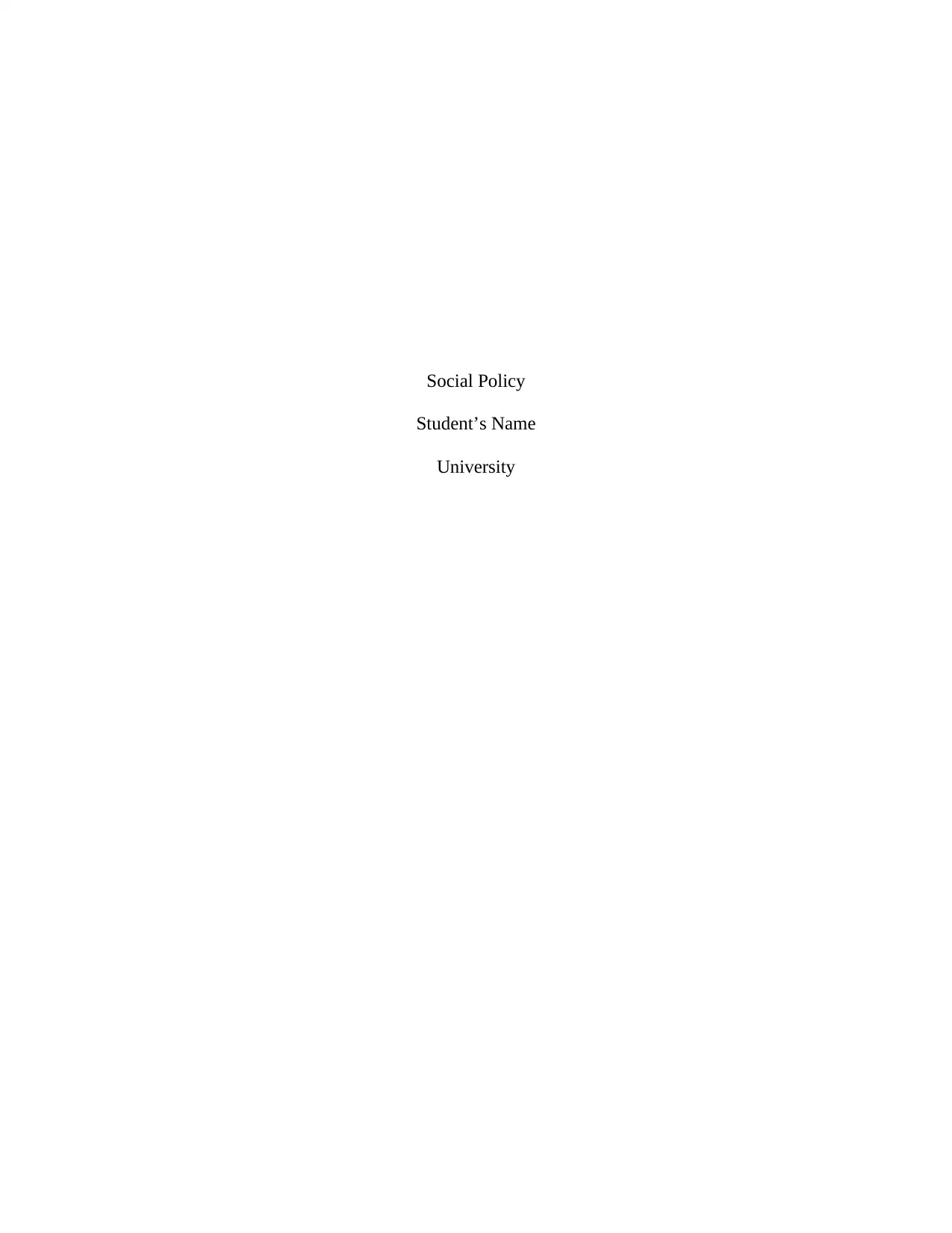
Social Policy
Student’s Name
University
Student’s Name
University
Paraphrase This Document
Need a fresh take? Get an instant paraphrase of this document with our AI Paraphraser
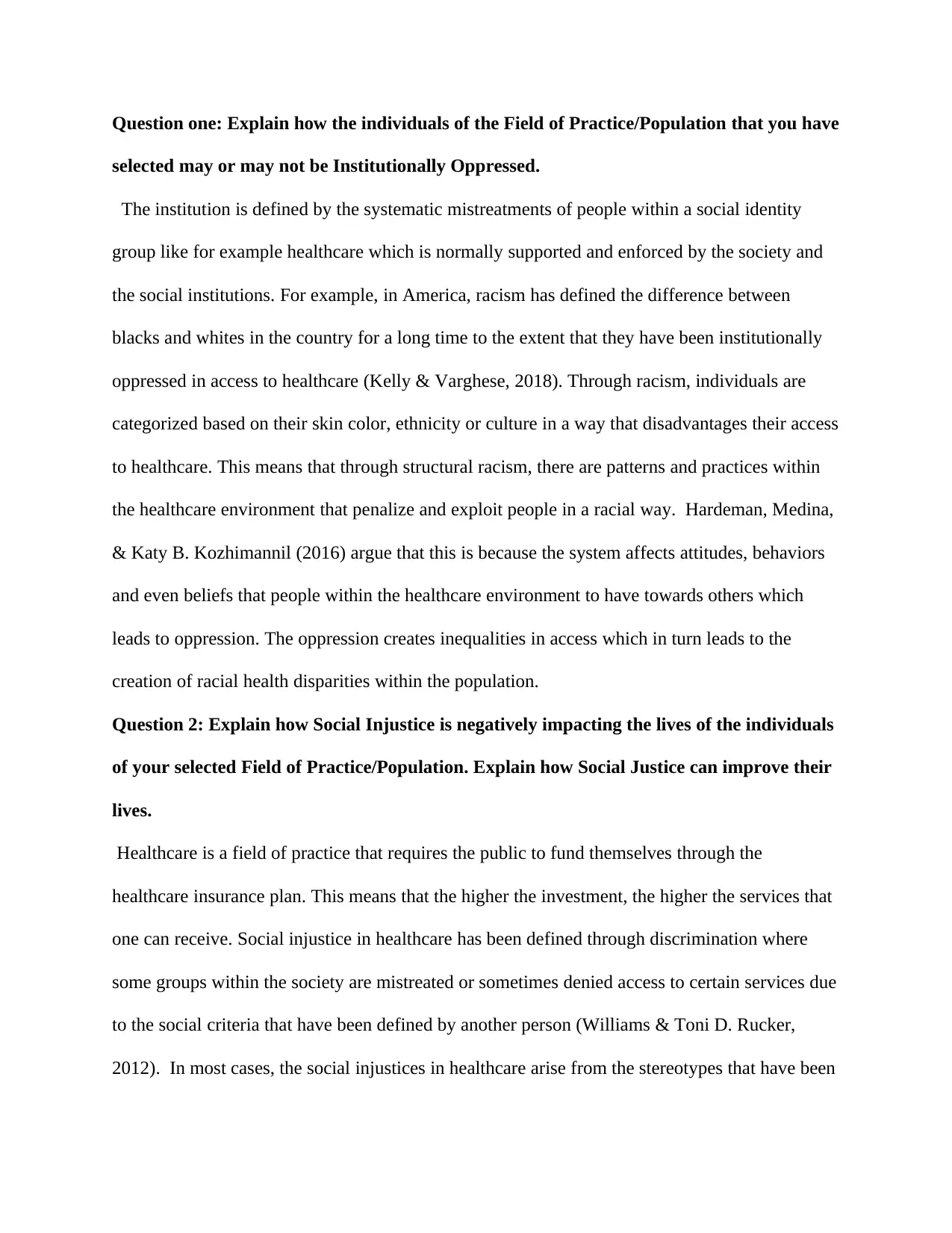
Question one: Explain how the individuals of the Field of Practice/Population that you have
selected may or may not be Institutionally Oppressed.
The institution is defined by the systematic mistreatments of people within a social identity
group like for example healthcare which is normally supported and enforced by the society and
the social institutions. For example, in America, racism has defined the difference between
blacks and whites in the country for a long time to the extent that they have been institutionally
oppressed in access to healthcare (Kelly & Varghese, 2018). Through racism, individuals are
categorized based on their skin color, ethnicity or culture in a way that disadvantages their access
to healthcare. This means that through structural racism, there are patterns and practices within
the healthcare environment that penalize and exploit people in a racial way. Hardeman, Medina,
& Katy B. Kozhimannil (2016) argue that this is because the system affects attitudes, behaviors
and even beliefs that people within the healthcare environment to have towards others which
leads to oppression. The oppression creates inequalities in access which in turn leads to the
creation of racial health disparities within the population.
Question 2: Explain how Social Injustice is negatively impacting the lives of the individuals
of your selected Field of Practice/Population. Explain how Social Justice can improve their
lives.
Healthcare is a field of practice that requires the public to fund themselves through the
healthcare insurance plan. This means that the higher the investment, the higher the services that
one can receive. Social injustice in healthcare has been defined through discrimination where
some groups within the society are mistreated or sometimes denied access to certain services due
to the social criteria that have been defined by another person (Williams & Toni D. Rucker,
2012). In most cases, the social injustices in healthcare arise from the stereotypes that have been
selected may or may not be Institutionally Oppressed.
The institution is defined by the systematic mistreatments of people within a social identity
group like for example healthcare which is normally supported and enforced by the society and
the social institutions. For example, in America, racism has defined the difference between
blacks and whites in the country for a long time to the extent that they have been institutionally
oppressed in access to healthcare (Kelly & Varghese, 2018). Through racism, individuals are
categorized based on their skin color, ethnicity or culture in a way that disadvantages their access
to healthcare. This means that through structural racism, there are patterns and practices within
the healthcare environment that penalize and exploit people in a racial way. Hardeman, Medina,
& Katy B. Kozhimannil (2016) argue that this is because the system affects attitudes, behaviors
and even beliefs that people within the healthcare environment to have towards others which
leads to oppression. The oppression creates inequalities in access which in turn leads to the
creation of racial health disparities within the population.
Question 2: Explain how Social Injustice is negatively impacting the lives of the individuals
of your selected Field of Practice/Population. Explain how Social Justice can improve their
lives.
Healthcare is a field of practice that requires the public to fund themselves through the
healthcare insurance plan. This means that the higher the investment, the higher the services that
one can receive. Social injustice in healthcare has been defined through discrimination where
some groups within the society are mistreated or sometimes denied access to certain services due
to the social criteria that have been defined by another person (Williams & Toni D. Rucker,
2012). In most cases, the social injustices in healthcare arise from the stereotypes that have been
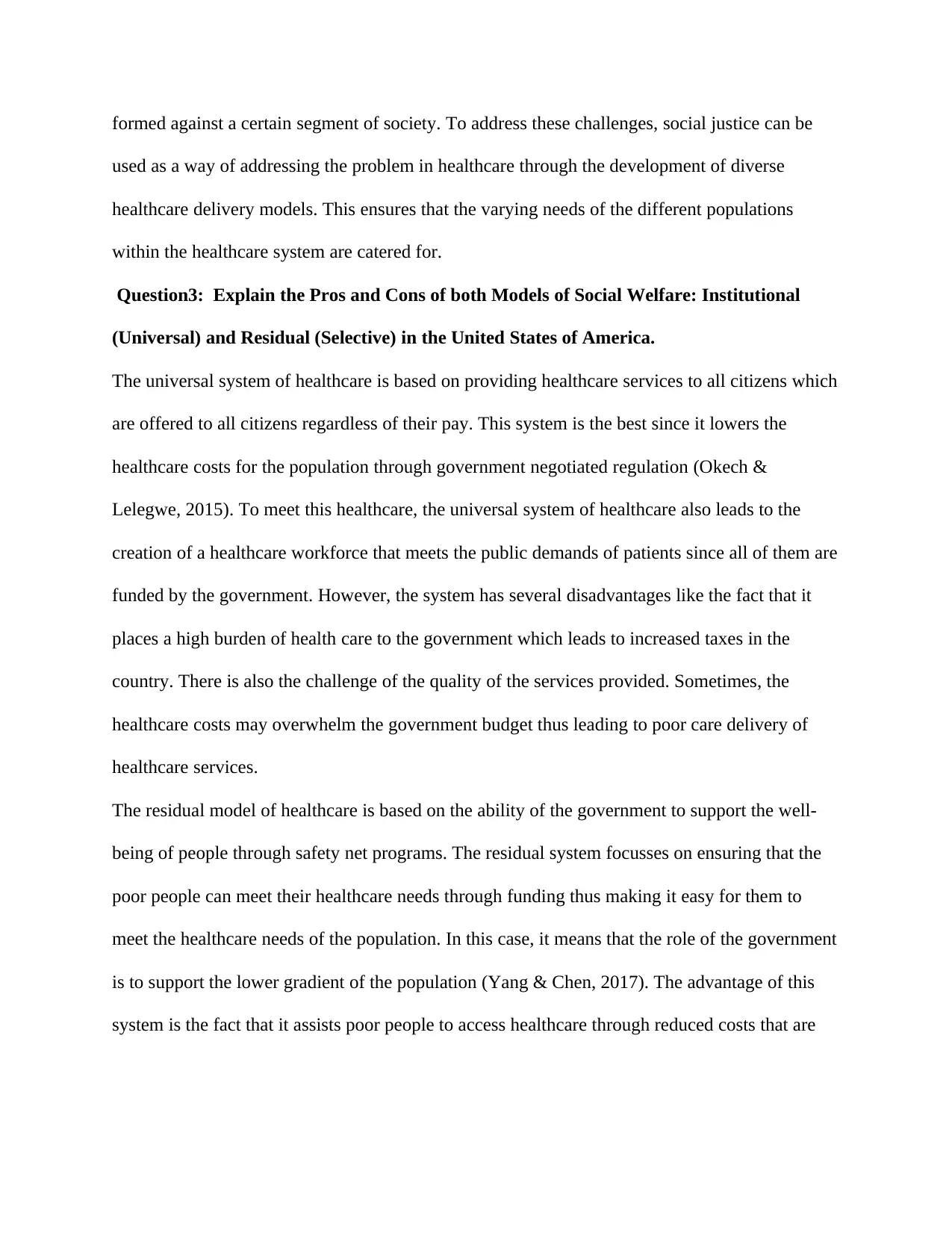
formed against a certain segment of society. To address these challenges, social justice can be
used as a way of addressing the problem in healthcare through the development of diverse
healthcare delivery models. This ensures that the varying needs of the different populations
within the healthcare system are catered for.
Question3: Explain the Pros and Cons of both Models of Social Welfare: Institutional
(Universal) and Residual (Selective) in the United States of America.
The universal system of healthcare is based on providing healthcare services to all citizens which
are offered to all citizens regardless of their pay. This system is the best since it lowers the
healthcare costs for the population through government negotiated regulation (Okech &
Lelegwe, 2015). To meet this healthcare, the universal system of healthcare also leads to the
creation of a healthcare workforce that meets the public demands of patients since all of them are
funded by the government. However, the system has several disadvantages like the fact that it
places a high burden of health care to the government which leads to increased taxes in the
country. There is also the challenge of the quality of the services provided. Sometimes, the
healthcare costs may overwhelm the government budget thus leading to poor care delivery of
healthcare services.
The residual model of healthcare is based on the ability of the government to support the well-
being of people through safety net programs. The residual system focusses on ensuring that the
poor people can meet their healthcare needs through funding thus making it easy for them to
meet the healthcare needs of the population. In this case, it means that the role of the government
is to support the lower gradient of the population (Yang & Chen, 2017). The advantage of this
system is the fact that it assists poor people to access healthcare through reduced costs that are
used as a way of addressing the problem in healthcare through the development of diverse
healthcare delivery models. This ensures that the varying needs of the different populations
within the healthcare system are catered for.
Question3: Explain the Pros and Cons of both Models of Social Welfare: Institutional
(Universal) and Residual (Selective) in the United States of America.
The universal system of healthcare is based on providing healthcare services to all citizens which
are offered to all citizens regardless of their pay. This system is the best since it lowers the
healthcare costs for the population through government negotiated regulation (Okech &
Lelegwe, 2015). To meet this healthcare, the universal system of healthcare also leads to the
creation of a healthcare workforce that meets the public demands of patients since all of them are
funded by the government. However, the system has several disadvantages like the fact that it
places a high burden of health care to the government which leads to increased taxes in the
country. There is also the challenge of the quality of the services provided. Sometimes, the
healthcare costs may overwhelm the government budget thus leading to poor care delivery of
healthcare services.
The residual model of healthcare is based on the ability of the government to support the well-
being of people through safety net programs. The residual system focusses on ensuring that the
poor people can meet their healthcare needs through funding thus making it easy for them to
meet the healthcare needs of the population. In this case, it means that the role of the government
is to support the lower gradient of the population (Yang & Chen, 2017). The advantage of this
system is the fact that it assists poor people to access healthcare through reduced costs that are
⊘ This is a preview!⊘
Do you want full access?
Subscribe today to unlock all pages.

Trusted by 1+ million students worldwide
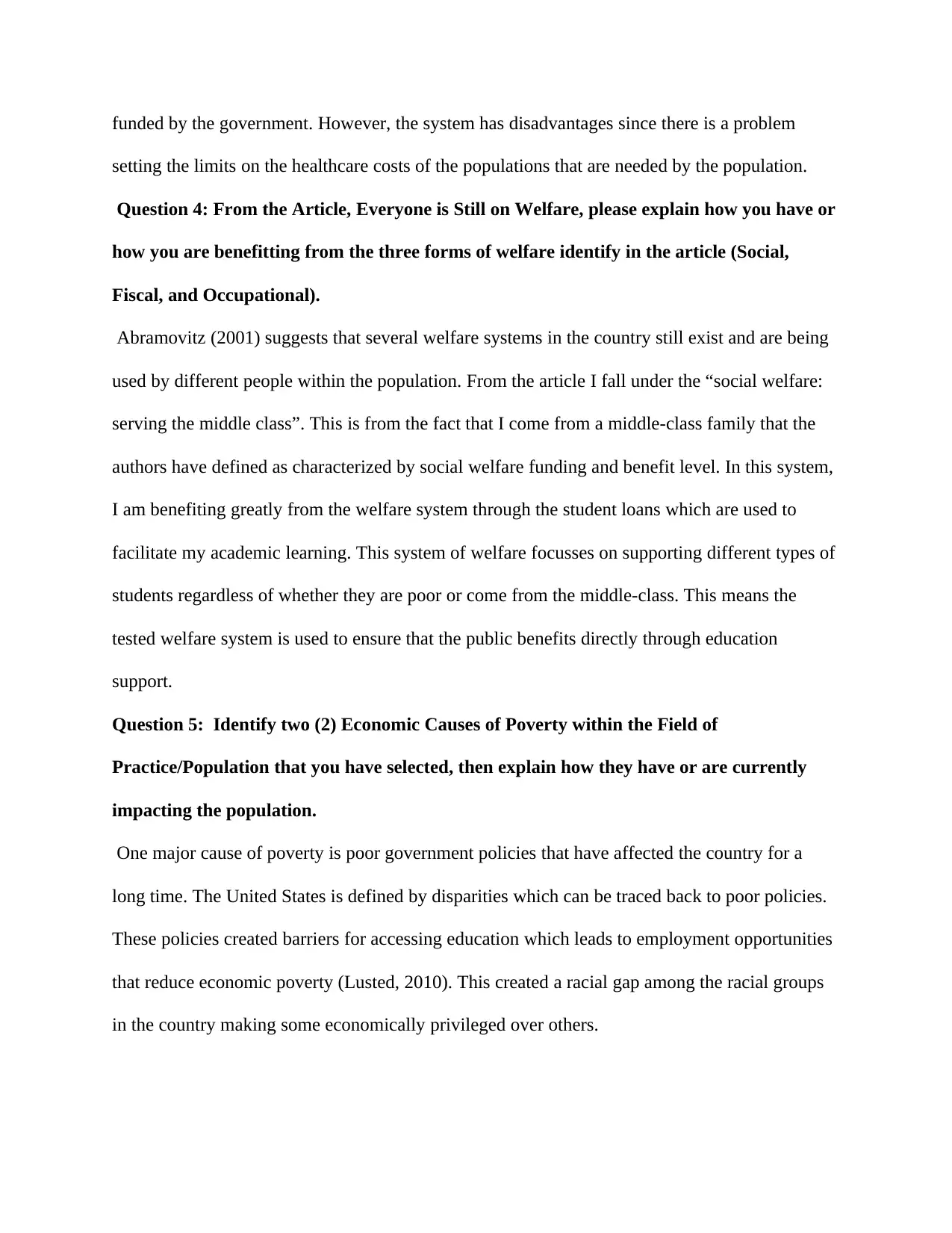
funded by the government. However, the system has disadvantages since there is a problem
setting the limits on the healthcare costs of the populations that are needed by the population.
Question 4: From the Article, Everyone is Still on Welfare, please explain how you have or
how you are benefitting from the three forms of welfare identify in the article (Social,
Fiscal, and Occupational).
Abramovitz (2001) suggests that several welfare systems in the country still exist and are being
used by different people within the population. From the article I fall under the “social welfare:
serving the middle class”. This is from the fact that I come from a middle-class family that the
authors have defined as characterized by social welfare funding and benefit level. In this system,
I am benefiting greatly from the welfare system through the student loans which are used to
facilitate my academic learning. This system of welfare focusses on supporting different types of
students regardless of whether they are poor or come from the middle-class. This means the
tested welfare system is used to ensure that the public benefits directly through education
support.
Question 5: Identify two (2) Economic Causes of Poverty within the Field of
Practice/Population that you have selected, then explain how they have or are currently
impacting the population.
One major cause of poverty is poor government policies that have affected the country for a
long time. The United States is defined by disparities which can be traced back to poor policies.
These policies created barriers for accessing education which leads to employment opportunities
that reduce economic poverty (Lusted, 2010). This created a racial gap among the racial groups
in the country making some economically privileged over others.
setting the limits on the healthcare costs of the populations that are needed by the population.
Question 4: From the Article, Everyone is Still on Welfare, please explain how you have or
how you are benefitting from the three forms of welfare identify in the article (Social,
Fiscal, and Occupational).
Abramovitz (2001) suggests that several welfare systems in the country still exist and are being
used by different people within the population. From the article I fall under the “social welfare:
serving the middle class”. This is from the fact that I come from a middle-class family that the
authors have defined as characterized by social welfare funding and benefit level. In this system,
I am benefiting greatly from the welfare system through the student loans which are used to
facilitate my academic learning. This system of welfare focusses on supporting different types of
students regardless of whether they are poor or come from the middle-class. This means the
tested welfare system is used to ensure that the public benefits directly through education
support.
Question 5: Identify two (2) Economic Causes of Poverty within the Field of
Practice/Population that you have selected, then explain how they have or are currently
impacting the population.
One major cause of poverty is poor government policies that have affected the country for a
long time. The United States is defined by disparities which can be traced back to poor policies.
These policies created barriers for accessing education which leads to employment opportunities
that reduce economic poverty (Lusted, 2010). This created a racial gap among the racial groups
in the country making some economically privileged over others.
Paraphrase This Document
Need a fresh take? Get an instant paraphrase of this document with our AI Paraphraser
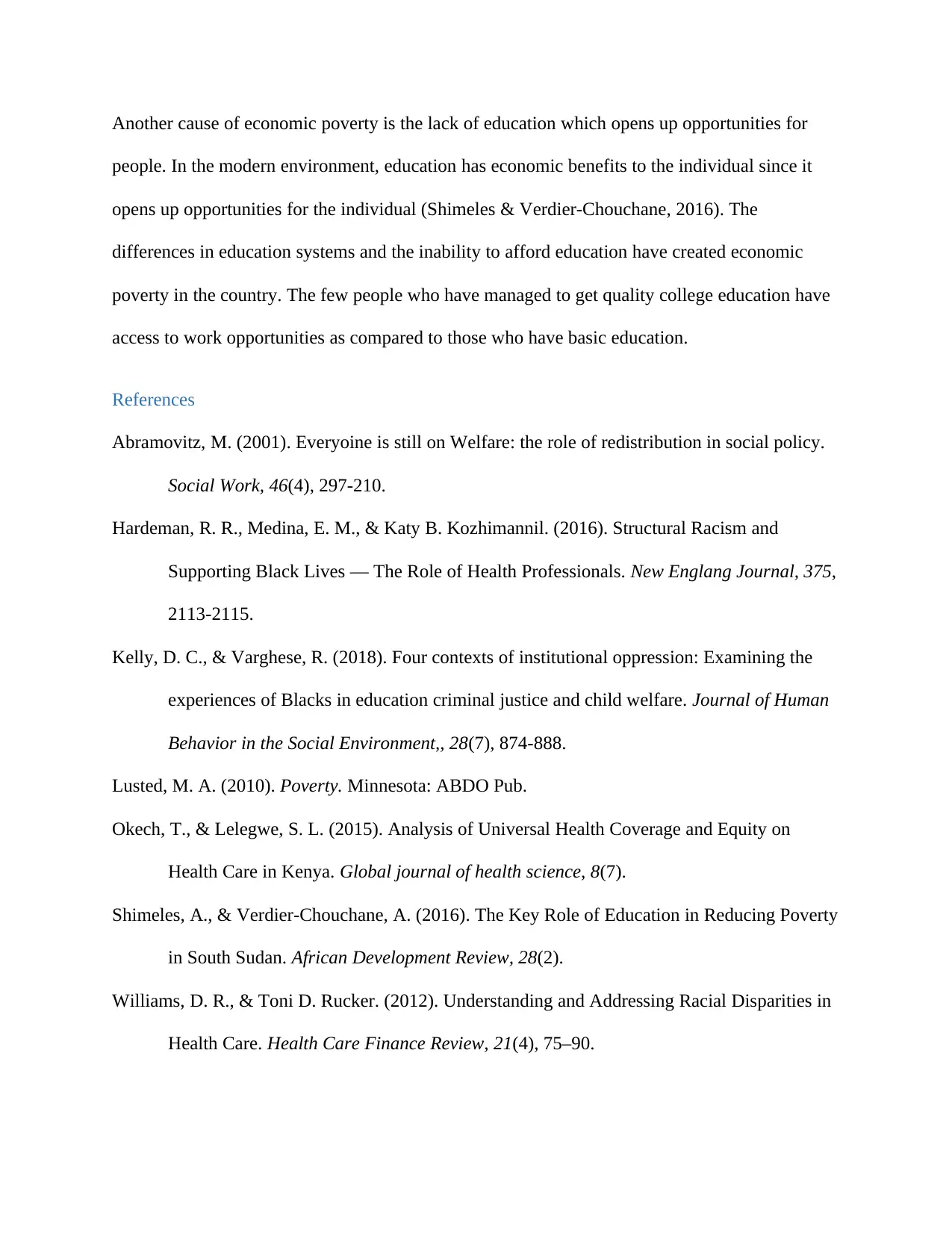
Another cause of economic poverty is the lack of education which opens up opportunities for
people. In the modern environment, education has economic benefits to the individual since it
opens up opportunities for the individual (Shimeles & Verdier‐Chouchane, 2016). The
differences in education systems and the inability to afford education have created economic
poverty in the country. The few people who have managed to get quality college education have
access to work opportunities as compared to those who have basic education.
References
Abramovitz, M. (2001). Everyoine is still on Welfare: the role of redistribution in social policy.
Social Work, 46(4), 297-210.
Hardeman, R. R., Medina, E. M., & Katy B. Kozhimannil. (2016). Structural Racism and
Supporting Black Lives — The Role of Health Professionals. New Englang Journal, 375,
2113-2115.
Kelly, D. C., & Varghese, R. (2018). Four contexts of institutional oppression: Examining the
experiences of Blacks in education criminal justice and child welfare. Journal of Human
Behavior in the Social Environment,, 28(7), 874-888.
Lusted, M. A. (2010). Poverty. Minnesota: ABDO Pub.
Okech, T., & Lelegwe, S. L. (2015). Analysis of Universal Health Coverage and Equity on
Health Care in Kenya. Global journal of health science, 8(7).
Shimeles, A., & Verdier‐Chouchane, A. (2016). The Key Role of Education in Reducing Poverty
in South Sudan. African Development Review, 28(2).
Williams, D. R., & Toni D. Rucker. (2012). Understanding and Addressing Racial Disparities in
Health Care. Health Care Finance Review, 21(4), 75–90.
people. In the modern environment, education has economic benefits to the individual since it
opens up opportunities for the individual (Shimeles & Verdier‐Chouchane, 2016). The
differences in education systems and the inability to afford education have created economic
poverty in the country. The few people who have managed to get quality college education have
access to work opportunities as compared to those who have basic education.
References
Abramovitz, M. (2001). Everyoine is still on Welfare: the role of redistribution in social policy.
Social Work, 46(4), 297-210.
Hardeman, R. R., Medina, E. M., & Katy B. Kozhimannil. (2016). Structural Racism and
Supporting Black Lives — The Role of Health Professionals. New Englang Journal, 375,
2113-2115.
Kelly, D. C., & Varghese, R. (2018). Four contexts of institutional oppression: Examining the
experiences of Blacks in education criminal justice and child welfare. Journal of Human
Behavior in the Social Environment,, 28(7), 874-888.
Lusted, M. A. (2010). Poverty. Minnesota: ABDO Pub.
Okech, T., & Lelegwe, S. L. (2015). Analysis of Universal Health Coverage and Equity on
Health Care in Kenya. Global journal of health science, 8(7).
Shimeles, A., & Verdier‐Chouchane, A. (2016). The Key Role of Education in Reducing Poverty
in South Sudan. African Development Review, 28(2).
Williams, D. R., & Toni D. Rucker. (2012). Understanding and Addressing Racial Disparities in
Health Care. Health Care Finance Review, 21(4), 75–90.
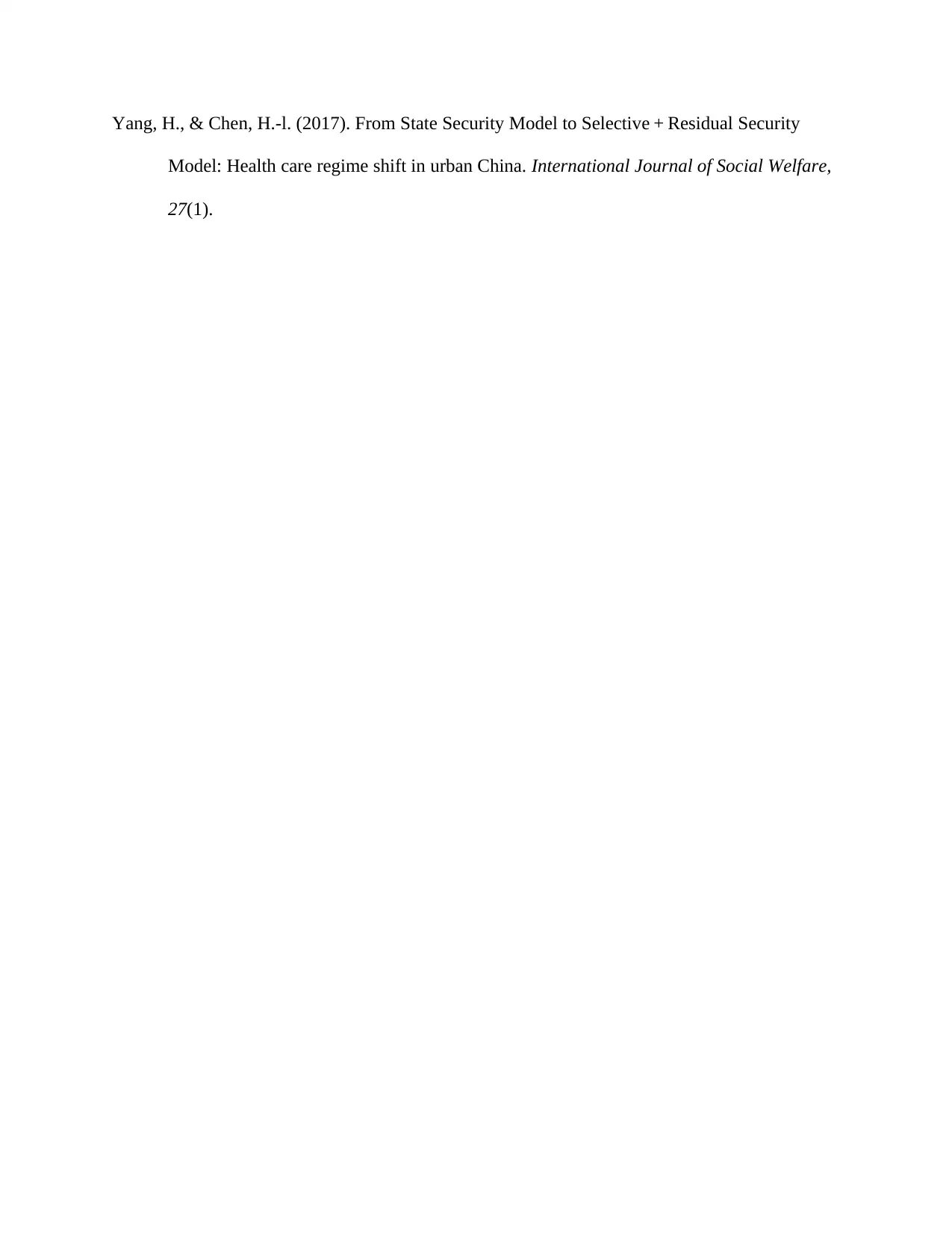
Yang, H., & Chen, H.‐l. (2017). From State Security Model to Selective + Residual Security
Model: Health care regime shift in urban China. International Journal of Social Welfare,
27(1).
Model: Health care regime shift in urban China. International Journal of Social Welfare,
27(1).
⊘ This is a preview!⊘
Do you want full access?
Subscribe today to unlock all pages.

Trusted by 1+ million students worldwide
1 out of 6
Related Documents
Your All-in-One AI-Powered Toolkit for Academic Success.
+13062052269
info@desklib.com
Available 24*7 on WhatsApp / Email
![[object Object]](/_next/static/media/star-bottom.7253800d.svg)
Unlock your academic potential
Copyright © 2020–2025 A2Z Services. All Rights Reserved. Developed and managed by ZUCOL.





